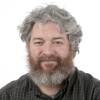MOORHEAD -- It’s 1,772 miles from Bad Medicine Lake in Becker County, Minn., to Tucson, Ariz. Going the other direction, it’s 2,995 miles from Bad Medicine to Húsavík, Iceland.
The lands and their people are different, but Wayne Gudmundson sees something similar in all of them: himself.
In three recent projects, the photographer, who splits time between homes on Bad Medicine and the Tucson area, explored the histories of those areas, to better understand the places he lives.
His look at Mahnomen, Becker and Clearwater Counties, “White Earth Window,” and his dive into the history of southern Arizona, “What Place is This,” opened at the Rourke Art Gallery + Museum last week .
On Thursday night, at Zandbroz Variety, Gudmundson will read from and discuss his new photo book, “A Song for Liv,” a nearly 30-year project looking at his own family history going back to his ancestors’ land in Iceland.
ADVERTISEMENT
“This sense of place has the capacity to be more than just a location,” Gudmundson says.

Raised in Moorhead, Gudmundson remembers family trips to Mountain, N.D., where he would listen as men gathered and recited verses by the Icelandic poet Kristján Niels Julíus.
As an adult in 1993, he traveled to Iceland to photograph the late poet’s home as well as his home ancestral landscapes. Inspired by songlines, a vocal roadmap that was often set to music to help being remembered, he started compiling the photos for his young daughter, Liv.
“People felt that if the song wasn’t sung, the song would die,” he says.
The book was finished when she was 17, but now, 17 years later and with two children of her own, Gudmundson felt he needed to rework the project. He showed it to North Dakota State University Press which agreed to publish the book of photos and notes on the landscapes that played a role in his and his daughter’s history.
“It’s not about my family. It’s about a search for a sense of place and people. The search becomes the song,” he says.
ADVERTISEMENT
Dark histories
That search was a different tune on Gudmundson’s other two projects.
He grew up spending summers at Bad Medicine and later bought property there to build a cabin. The lake and the land around it are part of the White Earth Reservation, and Gudmundson set out earlier in his career to create a documentary project about the area, a project on which he admits he “failed miserably,” due to the deep history and complexity of issues.

He would return to it time and again over the years and finally, with the help of Anton Treuer, a professor of Ojibwe at Bemidji State University, and a number of others with knowledge of the place and its people, he got traction.
The photos are similar to Gudmundson’s best known work, black and white photographs of the land in western Minnesota and North Dakota. While White Earth is more forested than the prairie to the west, Gudmundson still shoots with a straight-on approach with his large format camera.
“These pictures are sort of serene and contemplative,” he says.
The images may be calm, but the accompanying text can be upsetting. While some tell of how the land was used and cared for by the people of White Earth, others tell of how it was swindled and taken from them.
ADVERTISEMENT

“The story is long and sad and repetitive,” he says. “It was hard and difficult hearing these stories as the one white guy in the room. Story after story, it’s gut wrenching.”
Similarly tough was learning the history around his adaptive winter home in Tucson. Upon moving there, Gudmundson asked his friend Dieter Berninger, a fellow former Minnesota State University Moorhead professor, for five books to better understand south-eastern Arizona.
They went off to search out significant historical locations, many of them sites of battles and massacres and photographed the places as they are now.

Gudmundson says both “What Place is This” and “White Earth Window” invite the viewer in to explore the peacefulness of an image while the text may reveal a different history.
ADVERTISEMENT
“Both of these bodies of work have to do with me understanding where I’m living,” he says. “I feel more a part of the community now.”
After the shows close in October “What Place is This” will be donated to an Arizona arts organization and “White Earth Window” will be given to The Rourke to tour Western Minnesota through the Lake Agassiz Regional Libraries.
If you go
What: Wayne Gudmundson reading
When: 6:30 p.m., Thursday
Where: Zandbroz Variety, 420 Broadway, Fargo
Info: This event is free and open to the public
If you go
What: Wayne Gudmundson’s “White Earth Window” and “What Place is This”
When: On display through Oct. 12
Where: The Rourke Art Gallery + Museum, 521 Main Ave., Moorhead
Info: Open 1 - 5 p.m., Fridays - Sundays, free admission, https://www.therourke.org/









